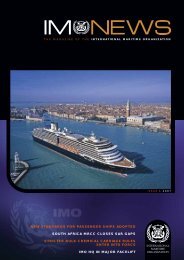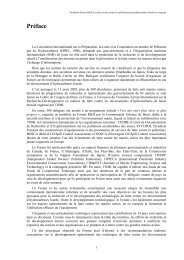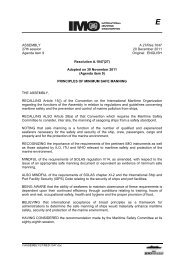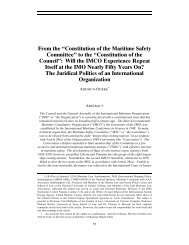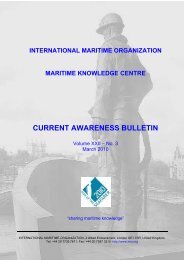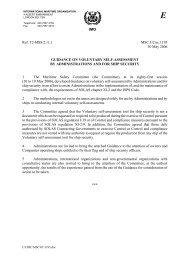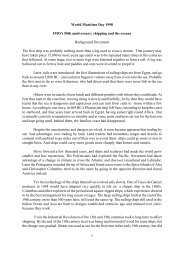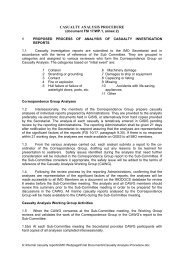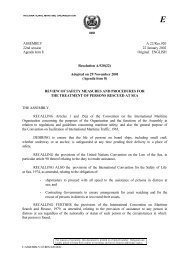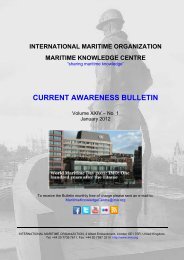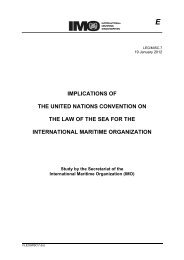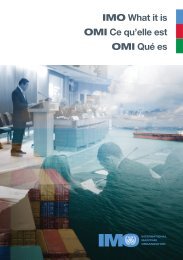Radioactive Waste Disposal at Sea: Public Ideas ... - IMO
Radioactive Waste Disposal at Sea: Public Ideas ... - IMO
Radioactive Waste Disposal at Sea: Public Ideas ... - IMO
You also want an ePaper? Increase the reach of your titles
YUMPU automatically turns print PDFs into web optimized ePapers that Google loves.
Knowledge-Based Regime Analysis 69<br />
planned programs for the management of resources if past degrad<strong>at</strong>ion of<br />
the environment and deterior<strong>at</strong>ion of ecosystems are to be corrected, if the<br />
biosphere’s productivity is to be maintained and even enhanced, and if aesthetic<br />
appreci<strong>at</strong>ion is given opportunity to flower.” (UNESCO 1970, p.<br />
234) But because the economic, social, and political dimensions of the<br />
problems of the biosphere were outside the purview of the Biosphere<br />
Conference (UNESCO is concerned primarily with science issues and scientific<br />
aspects of policy making), the final report made only vague recommend<strong>at</strong>ions<br />
for future legal and institutional changes. It concluded (ibid.,<br />
p. 235) th<strong>at</strong> “it has become clear . . . th<strong>at</strong> earnest and bold departures from<br />
the past will have to be taken n<strong>at</strong>ionally and intern<strong>at</strong>ionally if significant<br />
progress is to be made,” but the more precise n<strong>at</strong>ure of those “departures”<br />
was not mentioned. The 1972 Stockholm conference, in contrast, would<br />
focus on the economic, political, and social dimensions of protection of<br />
the global environment.<br />
“Man and His Environment: A View Toward Survival” was the telling<br />
title of the 13th N<strong>at</strong>ional Conference of the U.S. N<strong>at</strong>ional Commission for<br />
UNESCO dealing with the environment. The conference took place in<br />
November of 1969 <strong>at</strong> Stanford University and was <strong>at</strong>tended by represent<strong>at</strong>ives<br />
of more than 200 organiz<strong>at</strong>ions. Prominent environmentalists such<br />
as Paul Ehrlich, Barry Commoner, and Margaret Mead contributed background<br />
papers or particip<strong>at</strong>ed in panel discussions, or both. Considerable<br />
<strong>at</strong>tention was paid to ocean pollution as well as to control of popul<strong>at</strong>ion<br />
growth, reduction of <strong>at</strong>mospheric pollution, and preserv<strong>at</strong>ion of ecological<br />
diversity. One scientist warned th<strong>at</strong> “the end of the ocean came l<strong>at</strong>e in<br />
the summer of 1979 and it came even more rapidly than the biologists had<br />
expected” (Pryor 1970, p. 115). 33 Another contribution (The <strong>Sea</strong>: Should<br />
We Now Write It Off As a Future Garbage Pit?) was headlined as follows<br />
in an anthology (Riseborough 1970, pp. 121–136): “For those who don’t<br />
as yet believe th<strong>at</strong> the sea is dying, this is ample proof. For those who do, it<br />
is further document<strong>at</strong>ion.” It was concluded th<strong>at</strong> “scientific, practical, economic,<br />
moral, and esthetic reasons require th<strong>at</strong> the sea not be used as a<br />
garbage dump” (ibid., p. 122). Much as had happened <strong>at</strong> the Biosphere<br />
Conference, it was concluded th<strong>at</strong> intern<strong>at</strong>ional machinery was needed<br />
because DDT, polychlorin<strong>at</strong>ed biphenyls, 34 and radioactivity released by<br />
<strong>at</strong>omic explosions were capable of traveling gre<strong>at</strong> distances. The conference<br />
proposed th<strong>at</strong> “the leaders of all n<strong>at</strong>ions through the United N<strong>at</strong>ions



